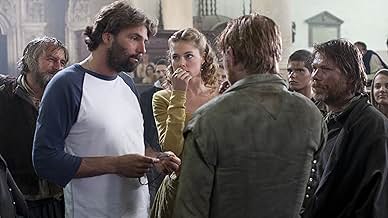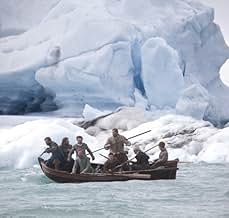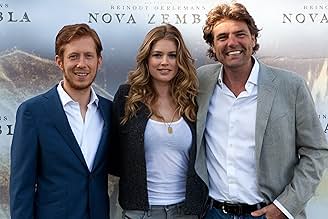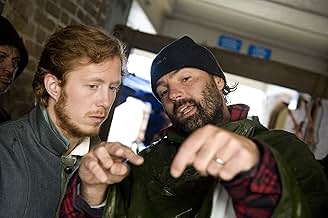Nova Zembla
- 2011
- 1 घं 48 मि
IMDb रेटिंग
5.8/10
4.8 हज़ार
आपकी रेटिंग
अपनी भाषा में प्लॉट जोड़ेंA Dutch exploration team sets sail to find the North East passage to the Indies. The weather had other ideas for them.A Dutch exploration team sets sail to find the North East passage to the Indies. The weather had other ideas for them.A Dutch exploration team sets sail to find the North East passage to the Indies. The weather had other ideas for them.
- निर्देशक
- लेखक
- स्टार
- पुरस्कार
- 2 जीत और कुल 2 नामांकन
फ़ीचर्ड समीक्षाएं
a good story, great ambitions of director, a shallow movie.and everybody is innocent. because desire to create a blockbuster was so great but details are ignored. to present a page of history is not an easy mission. and it is first sin of this project. a huge mountain and an army of Liliputans. and, for make the business more complicated - usual 3 D which, in this case,a real burden. it is not a bad film but only smoke of expensive cigar.because,wanting to tell all, it fails to provide anything. old clichés, dusty characters,great adventure without any crumb of emotion. so, second sin of movie is to create expectations. the last sin - Doutzen Kroes. beautiful, charming, she is only chain for too heavy pendant.
While I think the 3D-effect in today's cinema should enhance the human experience to get a certain feeling of stepping right into the scene, the three dimensional engineers of the Nova Zembla crew are taking the effect way too far. The extreme shallow dept-of-field (DOF) of most of the scenes creates an very unnatural effect. Not like the human eye it would see. 3D in Nova Zembla brings unnecessary unsharpness to wide shots instead of crisp details. It reminds me more of early cartoons and anime/manga than state-of-the-art improvement of the modern cinema experience. A missed chance for Reinout...
On the other hand, the shots from above (like the viewing angle used in the shots where we can see the boat from above) are well filmed. And the 3D-effect while filming from a lower angle through the grass does a great job. But those are just minutes of the whole movie play time.
On the other hand, the shots from above (like the viewing angle used in the shots where we can see the boat from above) are well filmed. And the 3D-effect while filming from a lower angle through the grass does a great job. But those are just minutes of the whole movie play time.
The Age of Exploration (or age of Discovery). Those 200 years (more or less) from 1450 to 1650, when a few brave men coming from Western Europe, traveling in fragile wooden ships and armed with primitive fire weapons, basically conquered the world. It's strange that very few movies have been made out of that era. Perhaps this is so because this era is now a bit politically incorrect (since it many times involved Europeans invading and conquering Native people). But movies dealing with early polar exploration should not have such a problem, since there were few if any native people there. So here comes this fine film from the Netherlands that tells the true story of Willem Barents, the Dutch navigator that seeking a Northern route to China (Spain, being in war with the Netherlands at the time make it difficult for Dutch ships to go to the east through the Cape of Good Hope) reached in 1596 (more than three centuries before the North Pole was reached) the island of Nova Zembla in the High Arctic Sea, an island that is now a part of Russia. However, the ice soon broke the ship and the crew has to spend in the island a harrowing winter. Shot in 3D mostly in Iceland, this film is handsomely made, with a good, classic storytelling. The story is mostly told through the eyes of Gerrit de Veer, the young, inexperienced chronicler in the expedition. Famous Dutch model Doutzen Kroes has a small role, appearing mostly in flashbacks, as Gerrit's fiancé back in Holland (she was obviously hired because she was believed to be a box office draw, not because her character was really needed in the story).
it is strange to define it. it is a homage to pioneers of geographic adventure, a history lesson, an inspired trip at the true essence of adventure, not ignoring the portrait of noble heroism ,but giving a realistic story . sure, using the precise expectations about artistic virtues, it is far to be a great movie. but it is a decent one. and this fact remains a significant good point. or,maybe, a reasonable portrait of brave men and theirs fight against nature.
There are a lot of things that can be said about this (typically Dutch) movie. Without a doubt, the adventures of Willem Barentz during his third voyage to find a way around "the North" and his stay on Nova Zembla merited an epic movie.
Even though Reinout Oerlemans is a very inexperienced director the quality of the production is mostly "acceptable". Great camera-work in general and pretty decent acting.
The biggest problem with the movie, however, is the script.
It deviates from what really happened in so many places it defies belief. Why Reinout Oerlemans and Hugo Heinen would have strayed so far from the truth is difficult to understand as much of the real story would have added to the tension.
They completely missed the reason for Barentz to become stuck in the ice contrary to his previous two attempts in sailing through the arctic, for instance. There are many more examples of "truth is stranger than fiction" to be found in this movie.
In the end the movie is dull and not very engaging. Constantly giving the viewer the sense of missed opportunities by the script.
The true story of Willem Barentz' voyage could easily have beaten "Titanic" in terms of suspense and majesty. Instead, this attempt can only be called a mediocre, unnecessary and (in places) simpleminded distortion of reality.
Even though Reinout Oerlemans is a very inexperienced director the quality of the production is mostly "acceptable". Great camera-work in general and pretty decent acting.
The biggest problem with the movie, however, is the script.
It deviates from what really happened in so many places it defies belief. Why Reinout Oerlemans and Hugo Heinen would have strayed so far from the truth is difficult to understand as much of the real story would have added to the tension.
They completely missed the reason for Barentz to become stuck in the ice contrary to his previous two attempts in sailing through the arctic, for instance. There are many more examples of "truth is stranger than fiction" to be found in this movie.
In the end the movie is dull and not very engaging. Constantly giving the viewer the sense of missed opportunities by the script.
The true story of Willem Barentz' voyage could easily have beaten "Titanic" in terms of suspense and majesty. Instead, this attempt can only be called a mediocre, unnecessary and (in places) simpleminded distortion of reality.
क्या आपको पता है
- ट्रिवियाThe real voyage started with two ships instead of one, but half way the second ship with captain Jan Cornelisz Rijp returned. The next year Rijp visits Northern Russia on a regular trade mission and accidentally meets with the surviving members of the first ship and brings them home. A theatrical element in itself, that was omitted in the story of the movie.
- गूफ़The bird Claes found suddenly changes from a young Puffin into a Jackdaw.
- कनेक्शनFeatured in De wereld draait door: एपिसोड #7.19 (2011)
टॉप पसंद
रेटिंग देने के लिए साइन-इन करें और वैयक्तिकृत सुझावों के लिए वॉचलिस्ट करें
- How long is Nova Zembla?Alexa द्वारा संचालित
विवरण
बॉक्स ऑफ़िस
- बजट
- €70,00,000(अनुमानित)
- दुनिया भर में सकल
- $1,09,87,361
- चलने की अवधि1 घंटा 48 मिनट
- रंग
- ध्वनि मिश्रण
- पक्ष अनुपात
- 2.35 : 1
इस पेज में योगदान दें
किसी बदलाव का सुझाव दें या अनुपलब्ध कॉन्टेंट जोड़ें

























